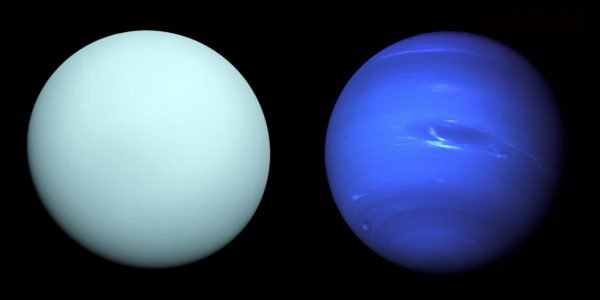Image credit: NASA/JPL-Caltech
The ice giants, Uranus and Neptune, form a separate family of the Solar System planets.
Not only are they very different from their rocky relatives ( Mercury, Venus, Earth and Mars), but also from the gas giants. Uranus and Neptune are not “just like gas planets, only frozen”, like our inflatable planetarium visitors often suggest. No, they are completely different from Jupiter and Saturn in terms of chemistry, structure and dynamics. Who would have thought!
But the most shocking blow for the scientists is not how the two oddballs are different from the other planets, but how they are different from each other. Uranus and Neptune have a number of similar features, all right, but each of them has some unique characteristics. What makes the two planets so different is one brain twisting mystery!
The similarities of the ice giants
It is easy to see why Uranus and Neptune are sometimes called “twin planets”. The two have comparable masses (14.5 and 17 Earth masses respectively) and radii (4.1 and 3.88 Earth Radii) and both rotate very fast (17.24 and 16.11 hours). The ice giants are situated extremely far away from the Sun (19.2 AU and 30.1 AU) and therefore receive very little sunlight and are VERY cold.
The appearance of these planets is very similar too. Their atmospheres are made of hydrogen, helium and methane with the last component being responsible for the planets blue colour. Although, of course, Uranus looks hazy and featureless, whereas Neptune has beautiful swirls, spots and stripes.
Deep down, the ice giants are both composed of “ices”, like, water, ammonia and methane. By ices astronomers mean volatile elements with boiling point above 100K, and not “frozen things”, as you might have thought. The ices inside the gas giants are most likely a liquid-ish “broth” that behaves like both gas and liquid.
Despite these similarities, Uranus and Neptune sport a number of unique features.
Uranus vs Neptune
-
Internal heat
Uranus is the coldest planet of the Solar System, it is even colder than Neptune! Not only there is very little heat reaching the planet from the Sun, but Uranus itself produces surprisingly little (internal) heat. Neptune, on the other hand, gives off 4 times more heat than it receives from the Sun. Why that is so, we can only guess.
-
The axial tilt
Uranus is the Solar System’s most crooked planet. Its axis of rotation is tilted 98 degrees so that the planet appears to roll on its side. The rings and the moons are tilted too! Neptune’s tilt, on the other hand, is 28.32 degrees, quite similar to that of the Earth and Mars!
-
Moons
Uranus has around 27 small to medium sized moons. The biggest of Uranus’ moons are regular, meaning they were all born in situ. Neptune has only 14 moons. The largest of them, a very weird Triton, is irregular (i.e. captured) moon. Triton is the 7th biggest moon in the Solar System and the only known irregular moon of this size. It orbits Uranus in the opposite direction from everything else in the Uranus’ system.
* To learn about the rings of Uranus and Neptune, their similarities and differences, read our blog post Rings around gas giants in the Solar System.
-
Core
We know very little about what’s inside the ice giants. Scientists suspect that the two planets have rocky cores. Uranus is thought to be more “centrally condensed” and probably has a bigger core than Neptune.
Why are the gas giants so different?
One possible explanations of the striking difference between the two planets involves giant impacts [that, as we know, were common in the early history of the Solar System].
This theory is especially favorable for Uranus as it explains the extreme tilt of the planet. A group of scientists from the University of Zurich recently performed computer simulations to see if the giant impacts could explain the features of BOTH planets. The astronomers concluded that the violent collisions, namely an oblique collision for Uranus and a head-on collision for Neptune, with Earth-sized objects might have lead the two initially extremely similar planets to develop into the very distinctive objects. They published their findings in the paper Bifurcation in the history of Uranus and Neptune: the role of giant impacts.
Some other astronomers, though, think that gravity rather than a planetary crash shaped the ice giants into what they are now. We definitely need to study Uranus and Neptune further, preferably in situ, to understand what is going on out there!
Exploration of the gas giants
The journey to the outer Solar System is long and expensive. To date, Voyager 2 remains the only spacecraft to visit Uranus and Neptune. But NASA, ESA and other space agencies are now looking into the possibility of sending a dedicated mission to study the ice giants. Why?
Not only are these planets fascinating and poorly understood members of our Solar neighbourhood, they also might be the most common type of planets outside the Solar System. That means if we learn more about Uranus and Neptune, we will be able to better understand exoplanets.
So yes, Uranus and Neptune are quite different from one another and we don’t really know why. But we finally have ways and means to find out. Isn’t that exciting?

